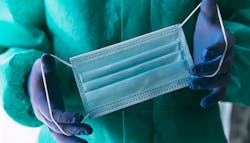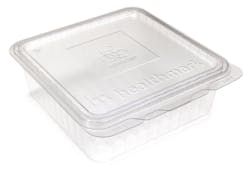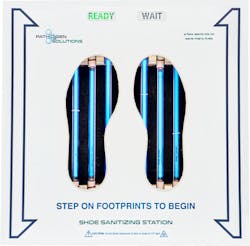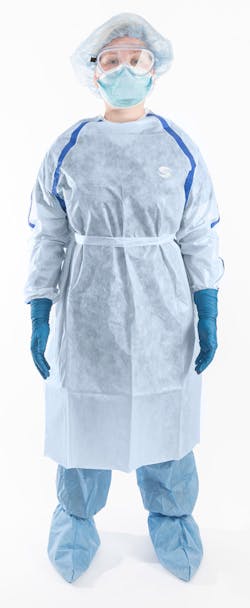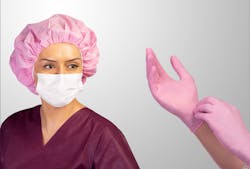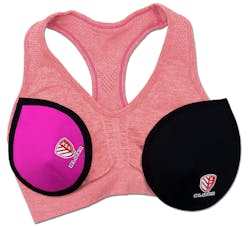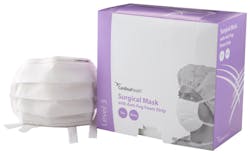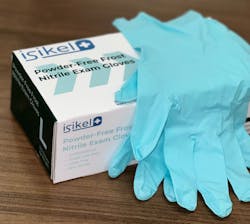Personal protective equipment (PPE) has become a household term because of the COVID-19 pandemic. We have all become too familiar with masks, gloves, face shields and other protective items. So, what more is there to say about the topic?
In fact, there is new research showing how common PPE may be inadequate in protecting healthcare workers (HCW) when handling contaminated instruments and devices. In some cases, it is the PPE itself that is contributing to cross contamination.
When looking outside the box of conventional PPE used to protect against microbes, there are product innovations to protect HCW against other dangers facing them each day, such as chemical and radiological hazards.
And with supply chain issues having become a way of life in the U.S., PPE manufacturers are bringing more production capacity onshore and nearshore to boost domestic inventory.
Protecting CS/SPD from splash back
Central Service/Sterile Processing & Distribution (CS/SPD) department teams manually decontaminate instruments and devices that can harbor human blood, tissue and secretions (e.g., urine, feces). They wear PPE to protect them from the splash that occurs while cleaning products in the decontamination sink, but recent research has shed light on the fact that it isn’t enough.
A study published in the October 2022 edition of the American Journal of Infection Control (AJIC) found manual cleaning of a colonoscope and a transvaginal ultrasound probe in a new sterile processing department of a large urban academic medical center generated droplets that traveled over seven feet from the sink, hitting the technician at the sink and observers three to four feet away.
Droplets were detected on counters, walls, a wall-mounted water filtration system, an irrigation system, a magnifying glass, a leak tester, floors and carts. Wearing shoe covers heavily exposed to droplets and puddles, technicians tracked moisture from the decontamination sink to an automated endoscope reprocessor, to the unit door, and out into the PPE foyer - a 15-foot path.1
“It is all a matter of degree. We know there will be droplets, but the fact that it spreads so far was the really interesting part to me,” said Pettis. “It’s one thing to say PPE is important, but to share something like this study is powerful, using real world science to help bring home the importance.”
Pettis says while wearing proper PPE, such as impermeable gowns, long heavy-duty gloves, full face shield, and head and shoe coverings, is essential to protecting staff against contamination, adherence to proper PPE doffing and hand hygiene procedures is equally, if not more important in some cases. This includes restriction of PPE doffing to the decontamination room, availability of hand hygiene products during and after doffing, and limiting hand washing to a designated clean sink.
“As infection preventionists and educators, we need to reevaluate how we’re doing this training and making these points to our staff members, including making sure we have visual cues always set up for them. As humans when we get familiar and comfortable with a process, we tend to get complacent, so training is not a one and done event. Again, using a study like this can help bring these points home.”
Personal protection during transport
The transport of dirty instruments from procedural areas to the CS/SPD department is another process that presents contamination risk to HCW, the environment and patients.
Stopping microbes in their tracks
Sometimes personal protection isn’t about what you wear, but the cleanliness of it. Recent research has shown how HCW can spread dangerous microbes from infected patients to other areas of a hospital through the soles of their shoes.
A study published in the August 2022 issue of The Journal of Hospital Infection describes how researchers cultured the shoe soles of HCW twice per shift while they were caring for patients infected with C. difficile on a general care floor of an acute-care institution. They also processed patients’ fecal samples by routine microbiological methods.
A total of 103 HCW exposed to 42 hospitalized patients participated in the study, providing 206 samples. Contamination of shoe soles with C. difficile was detected in 37 samples (17.8%). Upon comparing the patients’ and HCW’s C. difficile strains, 74% were linked epidemiologically to infected patients. The researchers note how this suggests potential transmission by of C. difficile by HCW’s shoe soles.2
PathO3Gen Solutions UVZone Shoe Sanitizing Station is an innovative multi-patented disinfection technology using the combined power of UVC light and ozone. It is on average 110x more effective than UVC alone, and as much as 346 times more effective for some microorganisms studied; eliminating up to 99.999% of the most harmful pathogens including Candida auris, E. coli, C. diff, MRSA, Klebsiella pneumoniae, Norovirus, and Human coronavirus from shoe soles in ≤ 8 seconds.
The UVZone Shoe Sanitizing Station is NSF International tested, TÜV SÜD Certified, EPA Registered, and manufactured in an ISO 9001-2015 facility in the USA.
Protecting against chemo drug exposure
The National Institute for Occupational Safety and Health (NIOSH) classifies antineoplastic drugs, including chemotherapy to treat cancer, as hazardous drugs. HCW exposed to them have increased risk for leukemia, other cancers, adverse reproductive outcomes, and chromosomal damage.3
While PPE is an essential part of protection, a NIOSH study found 12% of female nonpregnant nurses and 9% of pregnant nurses never wore gloves when administering antineoplastic drugs, and 42% of nonpregnant nurses and 38% of pregnant nurses reported never using a gown 4
“Cardinal Health Infection Control Apparel stays at the forefront of the regulatory environment, continuously evaluating and improving product offerings so customers can comply with industry best practices,” said Rosie Squeo, RN, BSN, MA, Senior Clinical Consultant in Business & Clinical Optimization at Cardinal Health. “Our newly developed, ChemoPlus Chemotherapy Gowns and Sleeves are chemo-tested and meet AAMI Level 3 and help protect against exposure to 16 types of chemotherapy drugs during preparation, handling, administration and more — wherever therapy is delivered.”
“This year, we also reintroduced our AAMI Level 3 Isolation Gowns that allow clinicians to level up for greater protection,” Squeo added. “These gowns, along with the new ChemoPlus gowns, are made in North America for greater supply resiliency.”
Tronex Healthcare Vice President Edmund Tai, says, “Make a statement in pink! Offering over three decades of expertise in disposable PPE, Tronex delivers a comprehensive line of GPO-contracted clinically preferred protective solutions.” Tai comments on the company’s new PINK line of PPE:
Shielding female clinicians from radiation
The U.S. Occupational Safety & Health Administration’s (OSHA) radiation protection standards are based on the premise that any radiation dose carries some risk, and that risk increases with dose. The OSHA website notes how “Some workers, such as radiology department workers, may be repeatedly exposed to low levels of ionizing radiation over the course of their careers.”
While the “resulting dose levels are almost always below the threshold doses needed for deterministic health effects to occur,” the government agency makes a point to state how “stochastic health effects, such as cancer, may occur years following the radiation dose.”6
For female clinicians, conventional radiation PPE garments, such as aprons, may not fit their body shape, leaving areas exposed. To enhance protection, BLOXR Solutions developed its BLOXR XPF Bra Inserts, which minimize occupational exposure of the breast area to scatter radiation for those medical personnel involved with x-ray and fluoroscopy.
“We are woman-owned and care about women’s health,” said President and CEO of BLOXR Solutions, Julia Jacobson. “We created these inserts based off discussions we had with female clinicians who were concerned with the ill-fitting x-ray protection gear they were given to wear. They are helpful especially when the size of the radiation protection garment provided doesn’t adequately cover the chest area.”
Designing PPE for clinician comfort
HCW are dealing with PPE fatigue after nearly three years of donning masks for protection against COVID-19. Among 250 HCW surveyed about facemask discomfort, 67% reported excessive sweating around the mouth, 58% difficulty in breathing on exertion, 56% acne, and 52% itchy nose.7
Boosting domestic PPE production
PPE shortages during the pandemic increased risk for infection among healthcare staff members and caused countless headaches for healthcare supply chain leaders. Nitrile gloves were one PPE category in scarce supply, with the demand for these products nearly doubling from 300 billion pieces in 2019 to 585 billion in August 2020. Surging demands caused prices to jump from $3 per box to a staggering $32.8
The shortage was in large part due to a heavy reliance on offshore manufacturing of these products, driving a subsequent boom in domestic PPE production.
United Safety Technology (UST) is focused on the domestic production of critical medical supplies to reduce our country’s reliance on foreign suppliers. Led by an international team of manufacturing and distribution experts, UST was awarded a $96.1M contract by the Department of Defense to manufacture medical-grade nitrile exam gloves on American soil.“Currently, the U.S. purchases upwards of $8 billion in nitrile gloves per year, and more than 98% of these products come from Asia, which puts our frontline workers at risk when supply chains are jeopardized,” said UST Chief Commercial Officer Will Benton. “UST is now in the process of opening a 735,000-square-foot production facility in Sparrows Point, Md., which will leverage a proprietary manufacturing model with enhanced automation to drive lower production costs. At full scale, UST plans to manufacture more than 10 billion gloves per year, while creating 1,500+ new jobs – with at least 30% for people with disabilities. Commercial production is projected to start in Q2 of 2023.”
“Led by a team of highly experienced management and chemical professionals, Isikel’s proprietary glove formula and dipping process raises the bar for consumer comfort and performance over foreign imports. Isikel is committed to being the ‘go to’ supplier of domestically produced PPE that customers can depend on.”
